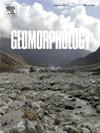富钾对层状火山向复合或破火山口演化的控制作用(爪哇岛)
IF 3.1
2区 地球科学
Q2 GEOGRAPHY, PHYSICAL
引用次数: 0
摘要
本研究的重点是将图像处理获得的形态计量学分析与已发表的晚第四纪爪哇火山(LQJV)地球化学和喷发参数数据相结合。首先,将火山类型定性为层状火山、复合火山和破火山口。接下来,我们进行了定量形态计量学分析,并整理了前人工作的地球化学数据。层状火山标志着火山最年轻的阶段,可大可小,但具有典型的陡峭和尖锐的形态,主要岩浆成分为玄武岩和安山岩岩浆。随着时间的推移,岩浆分化成更粘稠的成分(直到英安岩和流纹岩),层状火山可能发展成复合型,形成多个锥和更大的大厦尺寸。最后,火山口标志着最发达的火山类型,由于高度灾难性的喷发事件,它的典型的大而近乎平坦的形态。复合火山和破火山口火山都显示出明显重叠的二氧化硅含量,这表明二氧化硅不是控制爪哇岛破火山口形成的主要因素。有趣的是,爪哇岛所有火山口火山都表现出高钾岩浆亲和力,而复合火山则以中、低钾岩浆亲和力为主。这意味着钾元素在火山生长过程中是控制火山命运的最重要因素,要么只是变成一种化合物,要么演变成火山口。最近其他研究的发现进一步支持了这一观点,其中挥发物(例如CO2和H2O)在岩浆中的溶解度随着钾含量的增加而增加。事实上,巽他弧的大多数火山口(如多巴、曼尼乔、拉瑙、林贾尼和坦博拉)也表现出高钾亲和力(甚至是shoshontic),但这并不能否认这一观点。最后,我们还指出,不规则性和椭圆度指数更多地受外源因素(如先前存在的形态)的控制,而不是岩浆成分和喷发方式。本文章由计算机程序翻译,如有差异,请以英文原文为准。
On the possible role of potassium enrichment for controlling the morphological evolution of stratovolcanoes into compound or caldera (Java Island, Indonesia)
This study focuses on integrating the morphometry analysis (acquired from image processing) with the published geochemical and eruptive parameters data on the Late Quaternary Java Volcanoes (LQJV). First, we qualitatively discriminate the volcano type into stratovolcano, compound, and caldera. Next, we performed quantitative morphometrical analyses and compiled geochemistry data from previous works. Stratovolcano marks the youngest stage of a volcano, can be either small or large, but exhibits a typically steep and sharp morphology, with basaltic and andesitic magmas as the primary magma compositions. As time goes by and the magma differentiates into more viscous compositions (up to dacite and rhyolite), a stratovolcano may develop into a compound type, forming multiple cones and a larger edifice size. Finally, a caldera marks the most developed volcano type due to the typically large and nearly flat morphology as a result of the highly catastrophic eruptive event. Both compound and caldera volcanoes show a significantly overlapping silica content, suggesting that silica is not the main factor that controls the formation of a caldera on Java Island. Interestingly, all caldera volcanoes on Java Island always exhibit high-K magma affinity, while compound volcanoes are dominated by medium- and low-K affinity. This means that potassium occurs as the most important factor that controls the fate of a volcano during the growth process, either just becoming a compound or evolving into a caldera. This idea is further supported by the recent findings from other works, where the solubility of volatiles (e.g., CO2 and H2O) in magmas increases with increasing potassium content. The fact that most calderas in the Sunda Arc (e.g., Toba, Maninjau, Ranau, Rinjani, and Tambora) also exhibit high-K affinity (or even shoshonitic) does not deny this idea. Finally, we also pointed out that irregularity and the ellipticity index are more controlled by the exogenous factors (e.g., the preexisting morphology) instead of magma composition and eruption style.
求助全文
通过发布文献求助,成功后即可免费获取论文全文。
去求助
来源期刊

Geomorphology
地学-地球科学综合
CiteScore
8.00
自引率
10.30%
发文量
309
审稿时长
3.4 months
期刊介绍:
Our journal''s scope includes geomorphic themes of: tectonics and regional structure; glacial processes and landforms; fluvial sequences, Quaternary environmental change and dating; fluvial processes and landforms; mass movement, slopes and periglacial processes; hillslopes and soil erosion; weathering, karst and soils; aeolian processes and landforms, coastal dunes and arid environments; coastal and marine processes, estuaries and lakes; modelling, theoretical and quantitative geomorphology; DEM, GIS and remote sensing methods and applications; hazards, applied and planetary geomorphology; and volcanics.
 求助内容:
求助内容: 应助结果提醒方式:
应助结果提醒方式:


